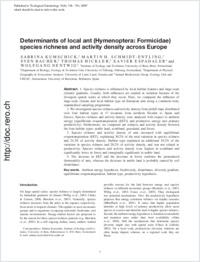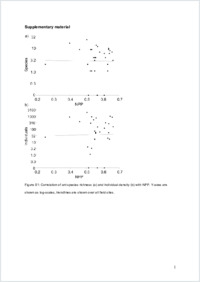Determinants of local ant (Hymenoptera: Formicidae) species richness and activity density across Europe
- Kumschick, Sabrina Institute of Ecology and Evolution, University of Bern, Switzerland
- Schmidt-Entling, Martin H. Institute of Ecology and Evolution, University of Bern, Switzerland
- Bacher, Sven Department of Biology, Ecology & Evolution Unit, University of Fribourg, Switzerland
- Hickler, Thomas Department of Physical Geography & Ecosystems Analysis, University of Lund, Sweden
- Espadaler, Xavier Animal Biodiversity Group, Ecology Unit and CREAF, Autonomous University of Barcelona, Bellaterra, Spain
- Nentwig, Wolfgang Institute of Ecology and Evolution, University of Bern, Switzerland
-
20.10.2009
Published in:
- Ecological Entomology. - 2009, vol. 34, no. 6, p. 748 - 754
Ambient energy hypothesis
biodiversity
disturbance
diversity gradient
equilibrium evapotranspiration
habitat type
productivity hypothesis
English
1. Species richness is influenced by local habitat features and large-scale climatic gradients. Usually, both influences are studied in isolation because of the divergent spatial scales at which they occur. Here, we compared the influence of large-scale climate and local habitat type on European ants using a continent-wide, standardised sampling programme.2. We investigated species richness and activity density from pitfall traps distributed over four habitat types at 17 locations from northern Sweden to Spain and Greece. Species richness and activity density were analysed with respect to ambient energy [equilibrium evapotranspiration (EET)] and productive energy (net primary productivity). Furthermore, we compared ant richness and activity density between the four habitat types: arable land, scrubland, grassland, and forest.3. Species richness and activity density of ants increased with equilibrium evapotranspiration (EET), explaining 30.2% of the total variation in species richness and 24.2% of activity density. Habitat type explained an additional 19.2% of the variation in species richness and 20.2% of activity density, and was not related to productivity. Species richness and activity density were highest in scrubland and significantly lower in forest and (marginally significant) in arable land.4. The increase in EET and the decrease in forest confirms the pronounced thermophily of ants, whereas the decrease in arable land is probably caused by soil disturbance.
- Faculty
- Faculté des sciences et de médecine
- Department
- Département de Biologie
- Language
-
- English
- Classification
- Biology, life sciences
- License
-
License undefined
- Identifiers
-
- RERO DOC 12937
- DOI 10.1111/j.1365-2311.2009.01127.x
- Persistent URL
- https://folia.unifr.ch/unifr/documents/301240
Other files
Statistics
Document views: 129
File downloads:
- pdf: 241
- Supplementary material: 132

